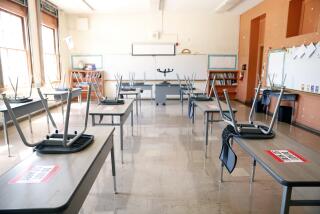Talk It Out, Don’t Duke It Out, Mediation Teaches Students
- Share via
Sean says Steve shoved him in the hallway. Donna says Sheila swore at her. Susan says Jose took her pencil. Bruce says Bill took his girlfriend.
But instead of duking it out, students at Santa Monica’s John Adams Middle School can mediate.
The program, organized by Santa Monica-based Dispute Resolution Services, unites quarreling students with peer mediators who help them settle disagreements. It aims to reduce fights and give students a cooperative outlook and a sense of responsibility, officials say.
“Conflict is a natural result of living,” said Judy Goldman, director of Dispute Resolution Services’ mediation program for schools, which includes the service at John Adams.
Facilities Donated
The organization (formerly the Neighborhood Justice Center) launched the $117,143-a-year program a year agp to try to “contain, focus and resolve (disputes) so they don’t distract from (students’) education” and to show that “it’s not necessarily true that there has to be a winner and a loser.”
The program runs on grants from the city of Santa Monica, Los Angeles County and the Los Angeles County Bar Foundation. Supplies, facilities and teacher time are donated by the Santa Monica-Malibu Unified School District.
Besides the peer mediation at John Adams, the program includes seminars on communication and conflict resolution for teachers, administrators, parents and students at the middle school and at four Santa Monica elementary schools. Program officials hope to start student mediation at Lincoln Middle School in Santa Monica by the spring of 1989.
But for now, John Adams’ peer mediation service, which is confidential and voluntary, is the only one in Southern California, according to Goldman, a former elementary school principal and an official of the National Assn. for Mediation in Education.
In 1985, there were 35 school mediation programs in the United States; now they number in the hundreds, she said. Programs of various sorts can be found in Phoenix, New York state, Massachusetts, New Mexico, Hawaii and the San Francisco Bay Area.
The 44 mediators at John Adams applied or were nominated for the position by fellow students and teachers. They were selected for their ability to keep secrets, listen carefully and make up assignments that they may miss when they are pulled out of class to mediate.
Several mediators said they wanted to participate because they thought it would help in their own relationships with siblings and friends.
“My friend was (a mediator) last year, and she said it was fun,” said seventh-grader Kokinda Johnson. “She said it automatically stays with you. Instead of fighting, you solve your problems.”
The students, who are of various ethnic backgrounds, went through 25 hours of training. At a recent session for new mediators, the students mediated for Goldilocks and one of the bears and for Cinderella and her stepmother. They learned to summarize people’s statements and practiced conveying frustration without blowing up. Instead of “Why did you cut in front of me in the lunch line, you jerk!”, it was “I feel upset when you get in front of me because I’m hungry and I waited in line and you didn’t.”
From late March to June, the mediators heard 116 fellow students in about 45 cases, according to Goldman. About 230 quarreling students are expected to go through the mediation center in Room 14 this year.
The mediators encounter cases that begin with everything from name calling to a shove to a look. One argument, mediator Carrie Green recalls, started when “a girl misunderstood a look. She thought two girls were challenging her to fight, so she challenged them to fight after school.”
Students who actually throw punches are generally assigned to study and clean up school grounds on Saturday or ordered to stay after school, Vice Principal Ardis Bonozo said. They also lose “merits,” points that bring gym privileges and special outings and assemblies. But if they go to mediation, they can earn back the merits.
Many students prefer to have help from their peers rather than from adults, mediators and former disputants say. Students think “it’s easier to work with people their own age, because they think kids are more understanding than adults,” said mediator Karrie Kingsley, a seventh-grader. Often, “an adult will talk down to them,” whereas “we just listen to what they have to say.”
Mediators say their practice has heightened their confidence and their cool. “You stay out of arguments,” said eighth-grader Daniel Stevens, who started mediating last year. New to the school last year, he was having “a lot of problems with my peers. People were poking fun at me, calling me names. Now it’s not as aggravating. I calm myself down a lot.”
Studies of school mediation programs elsewhere, such as in Poughkeepsie, N.Y., show similar results. At Poughkeepsie Middle School, where a peer mediation service was set up three years ago, the mediators’ confidence and concern for others has increased and fights and suspensions have decreased, said coordinator Nellie Mann. Most students surveyed said they would have gotten into fights if they hadn’t gone to mediation, she said.
However, a few students at John Adams, including some mediators, don’t think the program has brought impressive changes. Said Stevens: “There are not less fights, just more mediations.” Said Green: “It’s just now kids are more happy after mediation.”
More to Read
Sign up for Essential California
The most important California stories and recommendations in your inbox every morning.
You may occasionally receive promotional content from the Los Angeles Times.













